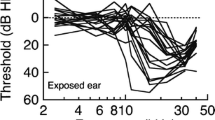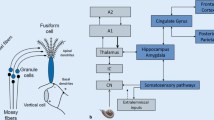Abstract
Tinnitus is the perception of a sound that has no external source. Sound stimuli can suppress spontaneous firing in auditory neurons long after stimulus offset. It is unknown how changes in sound stimulus parameters affect this forward suppression. Using in vivo extracellular recording in awake mice, we found that about 40 % of spontaneously active inferior colliculus (IC) neurons exhibited forward suppression of spontaneous activity after sound offset. The duration of this suppression increased with sound duration and lasted about 40 s following a 30-s stimulus offset. Pure tones presented at the neuron’s characteristic frequency (CF) were more effective in triggering suppression compared to non-CF or wideband noise stimuli. In contrast, non-CF stimuli often induced forward facilitation. About one third of IC neurons exhibited shorter suppression durations with each subsequent sound presentation. These characteristics of forward suppression are similar to the psychoacoustic properties of residual inhibition of tinnitus: a phenomenon of brief (about 30 s) suppression of tinnitus observed in tinnitus patients after sound presentations. Because elevated spontaneous firing in central auditory neurons has been linked to tinnitus, forward suppression of this firing with sound might be an underlying mechanism of residual inhibition.








Similar content being viewed by others
Abbreviations
- RI:
-
Residual inhibition
- IC:
-
Inferior colliculus
- AC:
-
Auditory cortex
- CF:
-
Characteristic frequency
- PSTH:
-
Peristimulus time histogram
References
Auerbach BD, Rodrigues PV, Salvi RJ (2014) Central gain control in tinnitus and hyperacusis. Front Neurol 5:206
Brozoski TJ, Bauer CA, Caspary DM (2002) Elevated fusiform cell activity in the dorsal cochlear nucleus of chinchillas with psychophysical evidence of tinnitus. J Neurosci 22:2383–2390
Dong S, Mulders WH, Rodger J, Woo S, Robertson D (2010) Acoustic trauma evokes hyperactivity and changes in gene expression in guinea-pig auditory brainstem. Eur J Neurosci 31:1616–1628
Ebert U, Ostwald J (1995) GABA can improve acoustic contrast in the rat ventral cochlear nucleus. Exp Brain Res 104:310–322
Eggermont JJ (2000) Sound-induced synchronization of neural activity between and within three auditory cortical areas. J Neurophysiol 83:2708–2722
Eggermont JJ (2016) Acquired hearing loss and brain plasticity. Hear Res xx:1–15
Eggermont JJ, Roberts LE (2012) The neuroscience of tinnitus: understanding abnormal and normal auditory perception. Front Syst Neurosci 6:53
Eggermont JJ, Roberts LE (2015) Tinnitus: animal models and findings in humans. Cell Tissue Res 361:311–336
Eggermont JJ, Tass PA (2015) Maladaptive neural synchrony in tinnitus: origin and restoration. Front Neurol 6:29
Feldmann H (1971) Homolateral and contralateral masking of tinnitus by noise-bands and by pure tones. Audiology 10:138–144
Finlayson PG, Kaltenbach JA (2009) Alterations in the spontaneous discharge patterns of single units in the dorsal cochlear nucleus following intense sound exposure. Hear Res 256:104–117
Galazyuk AV, Hebert S (2015) Gap-prepulse inhibition of the acoustic startle reflex (GPIAS) for tinnitus assessment: current status and future directions. Front Neurol 6:88
Galazyuk AV, Llano D, Feng AS (2000) Temporal dynamics of acoustic stimuli enhance amplitude tuning of inferior colliculus neurons. J Neurophysiol 83:128–138
Galazyuk AV, Lin W, Llano D, Feng AS (2005) Leading inhibition to neural oscillation is important for time-domain processing in the auditory midbrain. J Neurophysiol 94:314–326
Galazyuk AV, Wenstrup JJ, Hamid MA (2012) Tinnitus and underlying brain mechanisms. Curr Opin Otolaryngol Head Neck Surg 20:409–415
Grimsley CA, Longenecker RJ, Rosen MJ, Young JW, Grimsley JM, Galazyuk AV (2015) An improved approach to separating startle data from noise. J Neurosci Methods 253:206–217
Harris DM, Dallos P (1979) Forward masking of auditory nerve fiber responses. J Neurophysiol 42:1083–1107
Hays SA, Rennaker RL, Kilgard MP (2013) Targeting plasticity with vagus nerve stimulation to treat neurological disease. Prog Brain Res 207:275–299
Hazell JW, Wood S (1981) Tinnitus masking-a significant contribution to tinnitus management. Br J Audiol 15:223–230
Ison JR, Allen PD (2007) Pre-but not post-menopausal female CBA/CaJ mice show less prepulse inhibition than male mice of the same age. Behav Brain Res 185:76–81
Ison JR, Castro J, Allen P, Virag TM, Walton JP (2002) The relative detectability for mice of gaps having different ramp durations at their onset and offset boundaries. J Acoust Soc Am 112:740–747
Jastreboff PJ (1990) Phantom auditory perception (tinnitus): mechanisms of generation and perception. Neurosci Res 8:221–254
Jun HJ, Park MK (2013) Cognitive behavioral therapy for tinnitus: evidence and efficacy. Korean J Audiol 17:101–104
Kaltenbach JA (2011) Tinnitus: Models and mechanism. Hear Res 276:52–60
Kaltenbach JA, Afman CE (2000) Hyperactivity in the dorsal cochlear nucleus after intense sound exposure and its resemblance to tone-evoked activity: a physiological model for tinnitus. Hear Res 140:165–172. doi:10.1016/s0378-5955(99)00197-5
Langguth B, De Ridder D (2013) Tinnitus: therapeutic use of superficial brain stimulation. Handb Clin Neurol 116:441–467
Lipman RI, Lipman SP (2007) Phase-shift treatment for predominant tone tinnitus. Otolaryngol Head Neck Surg 136:763–768
Longenecker RJ, Galazyuk AV (2011) Development of tinnitus in CBA/CaJ mice following sound exposure. J Assoc Res Otolaryngol 12:647–658
Mulders WH, Robertson D (2009) Hyperactivity in the auditory midbrain after acoustic trauma: dependence on cochlear activity. Neuroscience 164:733–746
Nelson PC, Smith ZM, Young ED (2009) Wide-dynamic-range forward suppression in marmoset inferior colliculus neurons is generated centrally and accounts for perceptual masking. J Neurosci 29:2553–2562
Noreña AJ, Eggermont JJ (2003) Changes in spontaneous neural activity immediately after an acoustic trauma: implications for neural correlates of tinnitus. Hear Res 183:137–153
Olsen SØ, Nielsen LH, Osterhammel PAA, Rasmussen AN, Ludvigsen C, Westermann S (1996) Experiments with sweeping pure tones for the inhibition of tinnitus. J Audiological Medicine 5:27–37
Plappert CF, Rodenbücher AM, Pilz PK (2005) Effects of sex and estrous cycle on modulation of the acoustic startle response in mice. Physiol Behav 84:585–594
Portfors CV, Roberts PD (2007) Temporal and frequency characteristics of cartwheel cells in the dorsal cochlear nucleus of the awake mouse. J Neurophysiol 98:744–756
Relkin EM, Turner CW (1988) A reexamination of forward masking in the auditory nerve. J Acoust Soc Am 84:584–591
Roberts LE (2007) Residual inhibition. Prog Brain Res 166:487–495
Roberts LE, Moffat G, Bosnyak DJ (2006) Residual inhibition functions in relation to tinnitus spectra and auditory threshold shift. Acta Otolaryngol Suppl 556:27–33
Roberts LE, Moffat G, Baumann M, Ward LM, Bosnyak DJ (2008) Residual inhibition functions overlap tinnitus spectra and the region of auditory threshold shift. J Assoc Res Otolaryngol 9:417–435
Roberts LE, Eggermont JJ, Caspary DM, Shore SE, Melcher JR, Kaltenbach JA (2010) Ringing ears: the neuroscience of tinnitus. J Neurosci 30:14972–14979
Roberts LE, Bosnyak DJ, Bruce IC, Gander PE, Paul BT (2015) Evidence for differential modulation of primary and nonprimary auditory cortex by forward masking in tinnitus. Hear Res 327:9–27
Salvi RJ, Wang J, Ding D (2000) Auditory plasticity and hyperactivity following cochlear damage. Hear Res 147:261–274
Schleuning AJ, Johnson RM (1997) Use of masking for tinnitus. Int Tinnitus J 3:25–29
Sedley W, Gander PE, Kumar S, Oya H, Kovach CK, Nourski KV, Kawasaki H, Howard MA 3rd, Griffiths TD (2015) Intracranial mapping of a cortical tinnitus system using residual inhibition. Curr Biol 25:1208–1214
Shore SE (2011) Plasticity of somatosensory inputs to the cochlear nucleus—implications for tinnitus. Hear Res 281:38–46
Smalling JM, Galazyuk AV, Feng AS (2001) Stimulation rate influences frequency tuning characteristics of inferior colliculus neurons in the little brown bat, Myotis lucifugus. Neuroreport 12:3539–3542
Smit JV, Janssen ML, Schulze H, Jahanshahi A, Van Overbeeke JJ, Temel Y, Stokroos RJ (2015) Deep brain stimulation in tinnitus: current and future perspectives. Brain Res 1608:51–65
Smith RL (1977) Short-term adaptation in single auditory nerve fibers: some poststimulatory effects. J Neurophysiol 40:1098–1111
Sockalingam R, Dunphy L, Nam K, Gulliver M (2007) Effectiveness of frequency-matched masking and residual inhibition in tinnitus therapy: a preliminary study. Audiol Med 5:92–102
Spalding JA (1903) Tinnitus, with a plea for its more accurate musical notation. Archives of Otology 32:263–272
Terry AM, Jones DM, Davis BR, Slater R (1983) Parametric studies of tinnitus masking and residual inhibition. Br J Audiol 17:245–256
Turner JG, Brozoski TJ, Bauer CA, Parrish JL, Myers K, Hughes LF, Caspary DM (2006) Gap detection deficits in rats with tinnitus: a potential novel screening tool. Behav Neurosci 120:188–195
Tyler RS, Conrad-Armes D, Smith PA (1984) Postmasking effects of sensorineural tinnitus: a preliminary investigation. J Speech Hear Res 27:466–474
Vanneste S, De Ridder D (2012) Noninvasive and invasive neuromodulation for the treatment of tinnitus: an overview. Neuromodulation 15:350–360
Vernon JA, Meikle MB (1981) Tinnitus masking: unresolved problems. CIBA Found Symp 85:239–262
Vernon JA, Meikle MB (2003) Tinnitus: clinical measurement. Otolaryngol Clin N Am 36:293–305
Vernon J, Schleuning A (1978) Tinnitus: a new management. Laryngoscope 88:413–419
Voytenko SV, Galazyuk AV (2010) Suppression of spontaneous firing in inferior colliculus neurons during sound processing. Neuroscience 165:1490–1500
Voytenko SV, Galazyuk AV (2011) mGluRs modulate neuronal firing in the auditory midbrain. Neurosci Lett 492:145–149
Wehr M, Zador AM (2005) Synaptic mechanisms of forward suppression in rat auditory cortex. Neuron 47:437–445
Young ED, Sachs MB (1979) Representation of steady-state vowels in the temporal aspects of the discharge patterns of populations of auditory-nerve fibers. J Acoust Soc Am 66:1381–1403
Zhou X, Jen PH (2006) Duration selectivity of bat inferior collicular neurons improves with increasing pulse repetition rate. Chin J Physiol 49:46–55
Acknowledgments
We would like to acknowledge Dr. Larry Roberts, Dr. Arnaud Noreña, Dr. Merri Rosen, Inga Kristaponyte, and Greg Nelson for their comments on earlier versions of this manuscript. This research was supported by grant R01 DC011330 to A.V. Galazyuk and F31 DC013498-01A1 to R. J. Longenecker from the National Institute on Deafness and Other Communication Disorders of the US Public Health Service.
Author information
Authors and Affiliations
Corresponding author
Ethics declarations
All procedures used in this study were approved by the Institutional Animal Care and Use Committee at Northeast Ohio Medical University.
Conflict of Interest Statement
The authors declare that they have no conflict of interest.
Rights and permissions
About this article
Cite this article
Galazyuk, A.V., Voytenko, S.V. & Longenecker, R.J. Long-Lasting forward Suppression of Spontaneous Firing in Auditory Neurons: Implication to the Residual Inhibition of Tinnitus. JARO 18, 343–353 (2017). https://doi.org/10.1007/s10162-016-0601-9
Received:
Accepted:
Published:
Issue Date:
DOI: https://doi.org/10.1007/s10162-016-0601-9




